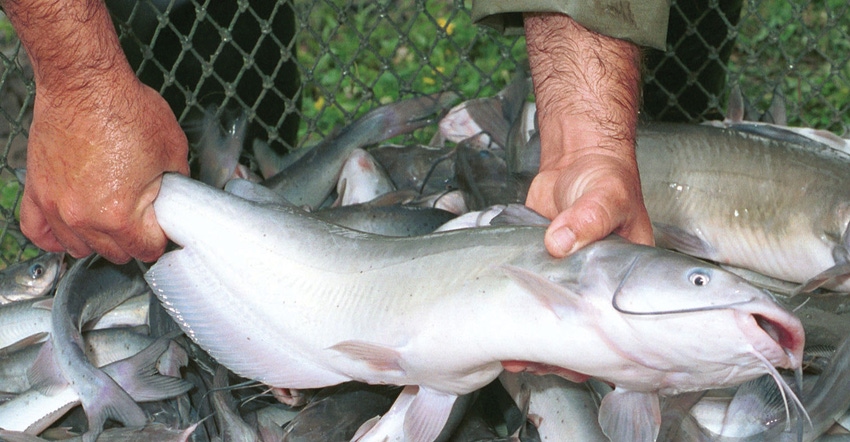
When catfish breeders crossed a channel catfish with a blue catfish, the result was a hybrid catfish with superior growth potential and increased disease resistance.
One trait of the new catfish was derived from the blue catfish — aggressive feeding. Because they are schooling fish in their natural environment, blue catfish are more competitive for food and grow well in crowded conditions. Although it yielded more meat, the fish’s great potential is its ability to excel at high stocking densities.
Catfish production systems had not change appreciably over the years. Big ponds that dotted the countryside across Alabama, Arkansas, Louisiana, and Mississippi were inefficient and difficult to manage.
“What we needed was a better way to control their environment and allow the genetic potential of this new ‘super catfish’ to be reached,” explains Dr. Craig Tucker, research leader, USDA/ARS Warmwater Aquaculture Research Unit in Stoneville, Miss. “Through a long process of collaborative work with Mississippi State University aquaculture researchers, a ‘split pond’ system was created.”
Researchers took a large, traditional catfish pond, drained it and installed a cross-levee that created a smaller pond from the remaining larger pond. Because fish create waste just like any other animal, they installed a paddle wheel to push waste water from the small pond into the larger pond that recycles the waste and produces needed oxygen.
The water is then pumped back into the smaller pond, completing the cycle and providing an improved environment promoting better fish growth and more efficient management by catfish farmers.
“There are about 3,000 acres of these new pond types in which just under 10 percent of domestic catfish are being produced today,” says Tucker.
Researchers also developed a more intensive production system where a 10-acre pond was split into two 5-acre ponds. Aeration horsepower was increased significantly so fish would not become stressed.
“Stocking rates for both systems are around 10,000 fish to the acre, and annual production can exceed 15,000 pounds of fish per acre — almost tripling average production from traditional ponds,” adds Tucker.
Mississippi State University researchers have created a much-needed vaccine delivery system to address a catfish health problem called “Enteric Septicemia of Catfish” (ESC), a bacterial-based disease that had caused consistent fish loss since the 1980s. Catfish farmers are optimistic about the potential impact because a vaccine can now be imparted on fish pellets and fed directly to catfish.
“ESC accounted for 27 percent of the cases submitted to the Aquatic Animal Diagnostic Lab each year,” says Dr. Jimmy Avery, Extension professor, National Warmwater Aquaculture Center, Mississippi State Extension Service.
Another breakthrough came after catfish researchers began to use a test called “Polymerase chain reaction” (PCR), a molecular genetic test that allows analysis of small samples of DNA. “PCR has been used for years in human health testing, but this was the first time it’s been used in catfish research,” adds Avery.
Through the PCR test, researchers can test pond mud or water samples, verify the presence of disease and offer advice accordingly.
Persistent Roadblocks
Despite these much-needed industry advancements, industry growth is still hampered by catfish imported from Vietnam and China.
“When feed costs escalated, our catfish farmers couldn’t pass costs on to the next stop in the supply chain, and it debilitated the industry,” says Avery. “We’re still dealing with the fact that anywhere from 60 to 70 percent of the catfish eaten in the U.S. today are imported.”
The premium size catfish filet is 3 to 7 ounces. There is limited market demand for filets much above that size. An unanticipated industry conundrum was created after the introduction of the hybrid catfish resulted in more large fish being produced. Processors found it difficult to find markets for the large filets produced from this size fish.
“When you order catfish, a filet that is 3 to 7 ounces is the most popular sold by restaurants,” adds Avery. “Because the market for these larger filets is limited, those big filets started building up in processors’ freezers and catfish farmers began receiving less for fish over 2 pounds.”
The industry is trying to develop new markets for these larger filets. “A large deep-skinned filet marketed as ‘Delacata’ has seen limited success,” says Avery. “However, most other product forms take more processing time and labor, and processors have struggled to recover the extra costs.”
Simmons Catfish in Yazoo City, Miss., has been marketing the Delacata cut of catfish to a few fine-dining restaurants across the Mid-South. The Delacata cut looks much like a halibut, and is considered the filet mignon of catfish.
“We’ve gotten the Veranda restaurant in Starkville, Miss., and Bravo Italian Restaurant in Jackson, Miss., to include it on their menus,” says Katy Prosser, director of marketing, Simmons Catfish. “We’ve been marketing this cut for five years. It’s perfect for baking, sautéing, or grilling.”
The Simmons Catfish web site http://www.simmonscatfish.com/ includes a list of restaurants, grocers, and distributors who the carry their catfish product line.
About the Author(s)
You May Also Like




